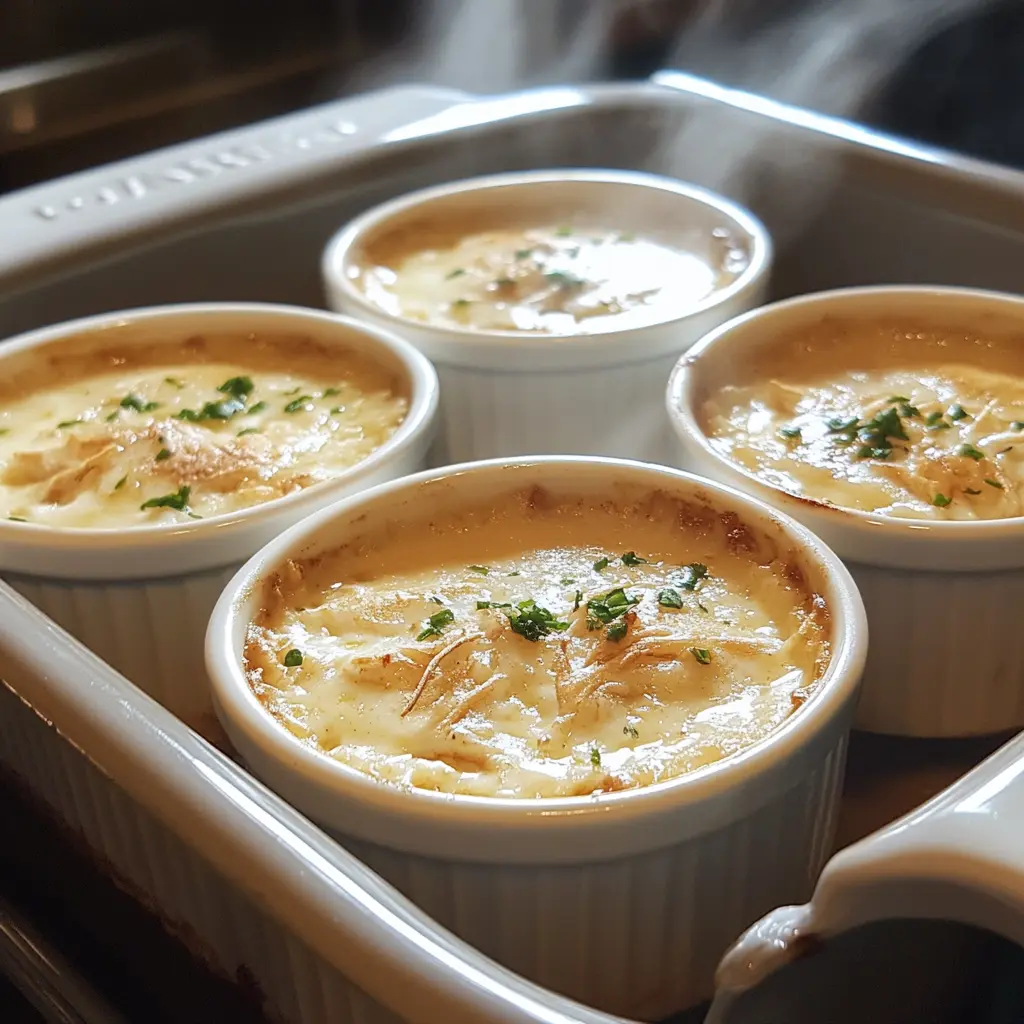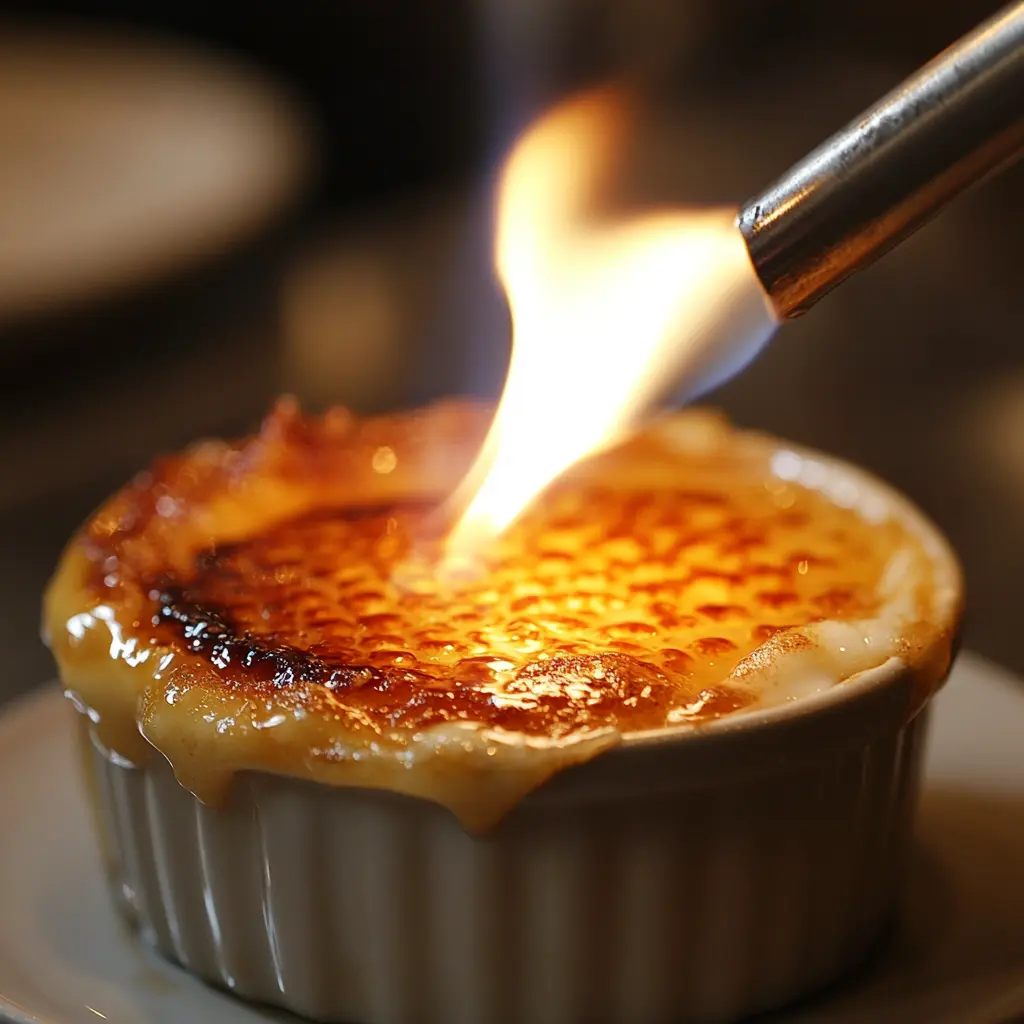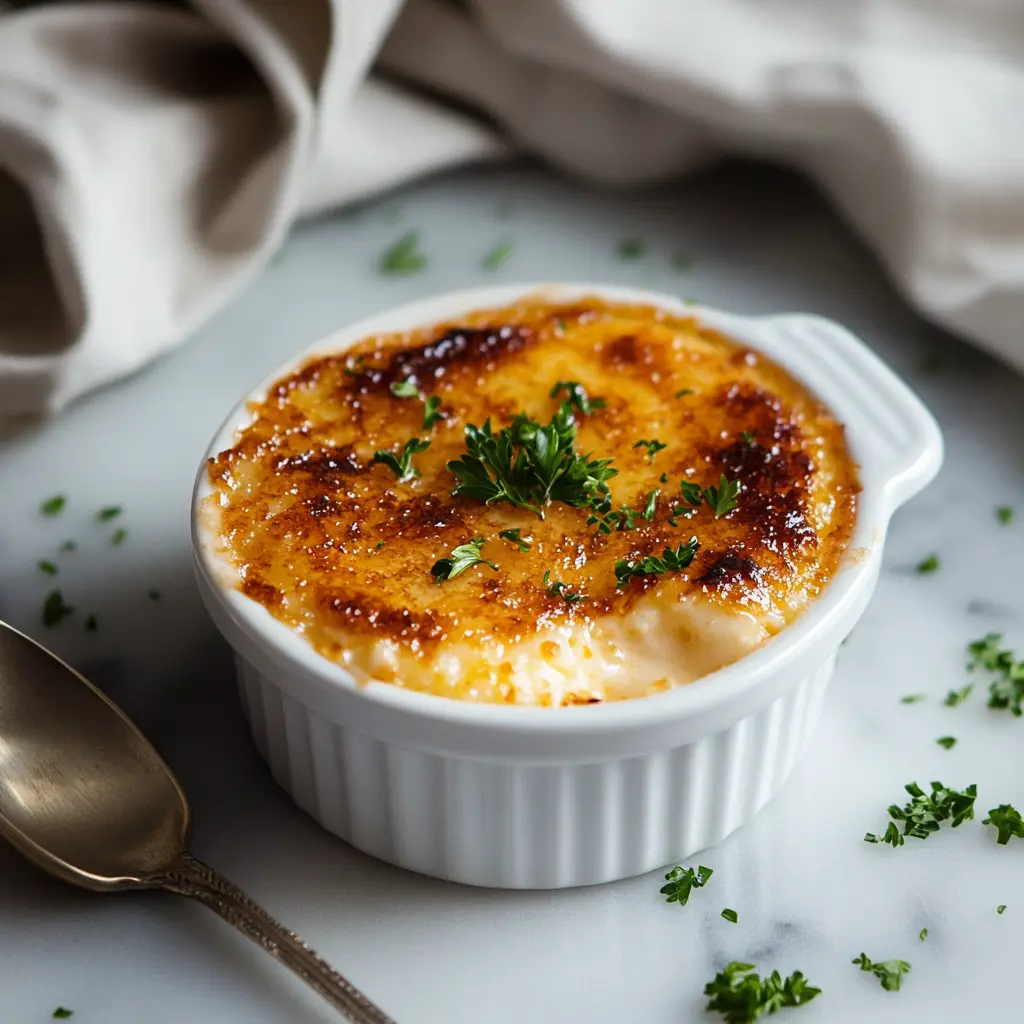Crab brûlée is the perfect combination of rich, creamy custard and the delicate, slightly sweet flavor of crab meat. This savory twist on the traditional crème brûlée brings sophistication to any table, whether you’re hosting a dinner party or treating yourself to a gourmet experience. By combining subtle seasoning, quality ingredients, and a caramelized sugar topping, this dish delights the palate with its unique contrast of textures and tastes. Let’s dive into the fascinating world of crab brûlée!
Part 1: Introduction to Crab Brûlée
What is Crab Brûlée?
Crab brûlée is an innovative twist on the classic crème brûlée, transforming this dessert into a savory masterpiece. While traditional crème brûlée is known for its sweet custard base topped with a caramelized sugar crust, crab brûlée replaces sugary flavors with the delicate essence of seafood. The custard’s silky texture and the slightly crisp sugar topping remain, but the result is a savory indulgence that pairs perfectly with a variety of dishes.
This dish caters to food lovers seeking an adventurous twist on a French classic. It also highlights the versatility of crab meat, making it an ideal option for special occasions or a show-stopping appetizer.
History and Evolution of Crab Brûlée
The origins of crème brûlée date back to France, where chefs mastered the art of balancing creamy custards with a crunchy caramelized topping. Over time, the concept of brûlée evolved, and culinary innovators began experimenting with savory alternatives. Enter crab brûlée—a modern creation that gained popularity in fine dining circles for its bold combination of seafood and creamy textures.
Chefs and home cooks alike embraced the versatility of crab, pairing it with custard to create an indulgent, savory dish that mimics the elegance of the original crème brûlée. Today, it’s celebrated as a unique fusion of gourmet techniques and fresh, high-quality ingredients.
Part 2: Ingredients and Preparation
Selecting the Right Crab Meat
When crafting a memorable crab brûlée recipe, the quality of crab meat you choose can make all the difference. Fresh crab meat is often the gold standard, delivering unmatched sweetness and tenderness. Look for options like Dungeness or blue crab, as their flavor profiles complement the rich custard beautifully.
If fresh crab isn’t accessible, fear not—canned or frozen crab meat can work in a pinch. However, always drain and pat it dry to avoid introducing excess moisture into the custard mixture. Whichever type you choose, ensure the meat is free of shells for a flawless texture.
Essential Ingredients for Crab Brûlée
A successful crab brûlée relies on a carefully curated blend of ingredients. Each component contributes to its layered flavor and smooth consistency:
- Crab Meat: The star of the dish, offering a subtle sweetness and rich texture.
- Heavy Cream: Creates the creamy base that defines any good brûlée.
- Egg Yolks: These act as the binder, ensuring a luscious custard.
- Seasonings: A pinch of salt, black or white pepper, and nutmeg enhances the savory notes.
- Lemon Zest: Optional but recommended for a hint of brightness.
- Chopped Herbs: Fresh parsley or chives add a refreshing herbal touch.
- Sugar: For the iconic caramelized topping.
Substitutions are possible for dietary preferences or ingredient availability. For example, a touch of coconut cream can replace heavy cream for a dairy-free option, and smoked paprika adds a smoky depth in place of nutmeg.
Step-by-Step Preparation Guide
Creating crab brûlée is simpler than you might think! Here’s how to bring this savory dish to life:

- Prepare the Custard Base:
- Start by separating egg yolks from whites. In a bowl, whisk the yolks until smooth.
- Heat heavy cream over medium heat, stirring gently to avoid scorching. Remove from heat just before it boils, then gradually temper it into the yolks while whisking continuously.
- Incorporate Crab Meat:
- Gently fold crab meat, seasonings, and a pinch of herbs into the custard base. Be careful not to overmix, as you want to preserve the delicate texture of the crab.
- Assemble Ramekins:
- Evenly distribute the custard mixture into individual ramekins. If desired, sprinkle a light layer of herbs on top for added flavor.
- Bake with Precision:
- Place the ramekins in a baking dish and pour hot water into the dish until it reaches halfway up the sides of the ramekins. Bake in a preheated oven at 320°F (160°C) for 35-40 minutes, or until the custard is set but still slightly jiggly in the center.
- Cool and Refrigerate:
- Allow the custards to cool to room temperature before refrigerating for at least 4 hours or overnight. This step ensures the custard sets fully and the flavors meld together.
- Caramelize the Sugar Topping:
- Just before serving, sprinkle an even layer of sugar over the custard. Use a kitchen torch to caramelize the sugar until it forms a golden, crispy crust.
Now, your crab brûlée is ready to impress with its creamy interior and irresistible sugar crust!
Part 3: Cooking Techniques and Tips
The Importance of the Water Bath (Bain-Marie)
When making a perfect crab brûlée recipe, mastering the water bath technique is crucial. This step ensures the custard bakes gently and evenly, preventing curdling or overcooking. A water bath works by insulating the ramekins, distributing heat uniformly during baking.
Here’s how to set up a water bath for foolproof results:
- Choose a deep baking dish that comfortably fits your ramekins.
- Arrange the ramekins, ensuring they don’t touch.
- Pour hot water into the dish until it reaches about halfway up the ramekins.
- Bake as instructed, keeping an eye on the water level. If it evaporates, carefully add more during the baking process.
Using a water bath not only protects the custard’s texture but also creates a silky, creamy base that complements the crab’s delicate flavor. Trust me, it’s worth the extra step!
Achieving the Perfect Caramelized Sugar Topping
No crab brûlée recipe is complete without a flawless caramelized sugar crust. This topping provides a delightful contrast to the creamy custard underneath, adding a satisfying crunch to every bite.

Tips for Caramelizing Sugar:
- Choose the Right Sugar: Use superfine granulated sugar for even melting and caramelization.
- Torch Technique: Hold the torch at a 45-degree angle, moving it in small circles to avoid scorching any one spot.
- Uniform Layer: Spread the sugar thinly and evenly to ensure consistent caramelization.
If you don’t own a kitchen torch, no problem! Place the ramekins under your oven’s broiler for a few minutes, but keep a close eye to prevent burning.
Flavor Enhancements and Variations
The beauty of a crab brûlée recipe lies in its adaptability. While the classic version shines with minimal ingredients, adding subtle twists can elevate the dish:
- Herbs and Spices: Experiment with fresh dill, thyme, or tarragon for unique herbal notes. Spices like cayenne or smoked paprika add warmth and depth.
- Cheese: A sprinkle of Parmesan or Gruyère enhances the savory profile and complements the custard’s creaminess.
- Seafood Variations: Swap crab for lobster or shrimp, or try blending crab with other seafood for a complex flavor.
Each variation brings a fresh perspective, allowing you to customize your crab brûlée to suit different occasions or preferences. Whether traditional or experimental, this dish is sure to captivate!
Part 4: Serving and Pairing Suggestions
Presentation Ideas for Crab Brûlée
When serving crab brûlée, presentation is everything! This dish’s appeal lies not only in its taste but also in its visual allure. By paying attention to the details, you can elevate your serving style to impress even the most discerning guests.
Tips for a Stunning Presentation:
- Elegant Ramekins: Choose ceramic ramekins with clean lines or textured finishes to showcase the custard.
- Garnishes: Add a touch of color with freshly chopped herbs like parsley or dill. For a touch of zest, a curl of lemon peel works wonders.
- Plating: Serve the ramekins on small plates with a napkin underneath to prevent sliding and add a polished look.
Small details like these transform your crab brûlée from a simple dish into a restaurant-worthy experience.
Side Dishes and Accompaniments
Pairing the right side dishes with crab brûlée enhances its flavors and rounds out your meal. This savory custard pairs beautifully with light, refreshing options that balance its richness.
Perfect Pairings:
- Crisp Salads: A simple green salad with a lemon vinaigrette complements the brûlée’s creamy texture.
- Crunchy Breads: Serve with toasted baguette slices or crisp flatbread to add a contrasting crunch.
- Pickled Vegetables: Tangy pickles or pickled onions offer a zesty counterpoint to the custard’s smoothness.
Seasonal sides can also bring variety—think roasted asparagus in spring or a fresh tomato salad in summer. These accompaniments make crab brûlée the star of your menu while ensuring a harmonious dining experience.
Beverage Pairing Tips
For a non-alcoholic option, herbal iced teas or sparkling water infused with citrus are refreshing choices that don’t overpower the dish. These beverages keep the meal light and allow the flavors of the brûlée to shine through.
By considering the presentation, sides, and drinks, you create a cohesive meal that celebrates the unique qualities of crab brûlée.
Frequently Asked Questions (FAQs)
Can I use canned crab meat for crab brûlée?
Yes, canned crab meat can be used if fresh crab isn’t available. Be sure to drain it thoroughly and remove any excess moisture to maintain the custard’s creamy texture.
What’s the best way to caramelize the sugar topping without a torch?
If you don’t have a kitchen torch, place the ramekins under a broiler for a few minutes. Keep a close watch to prevent burning and ensure the sugar melts evenly.
How do I prevent the custard from curdling during baking?
To avoid curdling, always bake crab brûlée in a water bath at a low, steady temperature. Temper the egg yolks carefully when adding the hot cream, whisking constantly to avoid cooking the eggs.
Can crab brûlée be made ahead of time?
Absolutely! Prepare the custard and refrigerate it overnight. Caramelize the sugar topping just before serving to maintain its signature crunch.
What are some vegetarian alternatives to crab in this recipe?
For a vegetarian twist, substitute crab with finely chopped mushrooms or artichoke hearts. These ingredients mimic the texture of crab and pair well with the custard.
How should I store leftover crab brûlée?
Store leftover brûlée in the refrigerator, tightly covered, for up to two days. Refrain from adding the sugar topping until just before serving to keep it fresh.
What’s the difference between crème brûlée and custard?
The main difference lies in the finishing and texture. Crème brûlée is a type of custard that is enriched with a caramelized sugar topping, providing a distinct crunch. While custards are generally smooth and creamy, crème brûlée adds the element of contrast with its crisp sugar crust. Additionally, custards may vary in sweetness or be savory, while crème brûlée is traditionally sweet, with savory adaptations like crab brûlée emerging more recently.
What is crème brûlée made of?
Classic crème brûlée consists of egg yolks, heavy cream, sugar, and vanilla. These ingredients are blended to create a rich custard, which is then baked and topped with granulated sugar. The sugar is caramelized to form a thin, crunchy layer that complements the creamy base.
How to caramelize brûlée?
To caramelize crème brûlée, sprinkle a thin, even layer of granulated sugar over the chilled custard. Using a kitchen torch, move the flame in small circles to evenly melt the sugar. The sugar will transform into a golden, crisp crust. If a torch isn’t available, use your oven’s broiler, keeping the ramekins under direct heat for a few minutes while closely monitoring to avoid burning.
What does crème brûlée taste like?
Crème brûlée offers a luxurious combination of textures and flavors. The custard base is smooth, rich, and subtly sweet, often infused with vanilla or other flavors. The caramelized sugar topping adds a satisfying crunch and a toasty, slightly bitter note, balancing the sweetness of the custard. In savory versions like crab brûlée, the dish takes on a creamy, seafood-forward profile with a savory finish.
Conclusion
Crab brûlée is an exquisite dish that redefines savory custards. With its creamy base, delicate seafood flavor, and irresistible caramelized crust, it’s no wonder this recipe captivates food lovers. Whether you’re creating it as an appetizer or the star of a gourmet spread, crab brûlée offers endless possibilities for experimentation and customization. Try it today and share the joy of this culinary masterpiece with family and friends!

